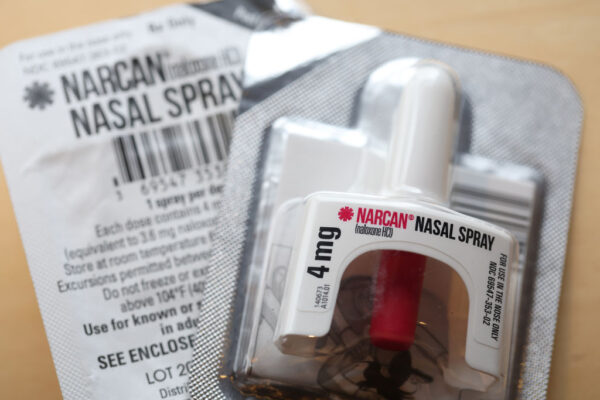
Over a million lives have been lost to drug overdoses since the start of the overdose crisis, with opioids accounting for 72% of these deaths. In 2023, the FDA approved naloxone (brand name Narcan) for over-the-counter purchase at pharmacies without a prescription. This marked a pivotal advancement in the expansion of the life-saving opioid overdose reversal medication. Available in the form of a user-friendly nasal spray, naloxone empowers people to be equipped with the emergency tool to reverse an opioid overdose and potentially save a life.
Despite being available over-the-counter in pharmacies, various barriers in accessing naloxone persist. One challenge is the inconsistent availability of naloxone. A multi-state study found that naloxone was often locked up or placed in hard-to-find locations in pharmacies across the country. While these pharmacies may technically stock and have naloxone available, they have struggled to make it accessible. After all, its availability is less meaningful if people cannot quickly and easily locate and purchase it. Another challenge is lack of access to pharmacies in the first place, particularly in rural areas. This geographic barrier makes obtaining naloxone even more difficult for those from medically underserved communities.
Cost remains another significant obstacle. A two-spray package of Narcan costs around $57, which can be a substantial barrier especially for those without insurance and for the large proportion of people who use drugs who live below the federal poverty line. Coupled with the barrier of societal stigma, negative perceptions surrounding substance use and addiction can often discourage people from going to a pharmacy to purchase naloxone.
Given the lifesaving potential of naloxone and its availability over-the-counter, it is critical to ensure that it is easily accessible to anyone who wishes to have it. One of the early efforts to address the aforementioned barriers was led by NEXT Distro, a national harm reduction nonprofit organization. Through their online mail-based naloxone delivery program, they provide free harm reduction resources directly to people’s doorstep. This approach effectively overcomes barriers such as cost, limited accessibility, geographic challenges, and the stigma associated with purchasing naloxone in-person. This proved to be particularly valuable during the pandemic, when additional barriers made accessing supplies in person more challenging.
However, the effectiveness of this program and other mail-based naloxone distribution initiatives could be substantially enhanced with active promotion and funding from county, city, or state governments and health departments. Because residents often rely on government health websites to find resources like naloxone, it is crucial for these sites to highlight information about the state’s availability of mail-based naloxone distribution programs. Delaware serves a model example of this. A simple Google search for “Delaware order naloxone online” directs users to HelpIsHereDE.com, a website established by the Delaware Division of Public Health through which residents in Delaware can find information about how to order naloxone online. Other states, such as California and Michigan, have implemented comparable measures, as a Google search of “California order naloxone online” and “Michigan order naloxone online” will take users to their respective Department of Health webpages, where they can access information about mail-based naloxone delivery.
However, it is important to note that only promoting this resource through government health websites is not sufficient. There are additional costs associated with mail-based delivery, as processing orders and shipping supplies increase expenses that were otherwise circumvented with in-person naloxone distribution. For this reason, it would be beneficial for local agencies to not only promote but also allocate funding toward supporting these mail-based programs. For instance, in New York, the Office of Addiction Services and Supports is utilizing opioid settlement funds to support their mail-based naloxone delivery program in partnership with NY MATTERS.
The opioid settlement funds provide a crucial opportunity to get increased state or municipal funding behind mail-based naloxone delivery, which can help to expand the impact of these programs. Furthermore, existing organizations like NEXT Distro already have a robust infrastructure in place and substantial experience in mail-based naloxone distribution, so through partnering with these organizations, municipalities can scale efforts efficiently. The systems are already available; it will require additional support from state and local governments to maximize its impact.
Photo by Justin Sullivan/Getty Images
Suhanee Mitragotri is an undergraduate student at Harvard University studying Neuroscience with a Secondary in Global Health and Health Policy. She is also the Co-Founder of the Naloxone Education Initiative, a program that aims to expand opioid and naloxone education to youth. She has written extensively on topics related to the opioid crisis, harm reduction, and drug policy and has published articles in various journals and magazines, including The Lancet Regional Health Americas, Addiction, Health Affairs Forefront, The Boston Globe, and New Scientist.
Kevan Shah, MSc, MSM, is an MD Candidate at Cooper Medical School of Rowan University. He is the founder and executive director of End Overdose Together, which aims to train and equip individuals to prevent opioid overdose.
Dr. Avik Chatterjee is an Assistant Professor at Boston University Chobanian and Avedisian School of Medicine and a med-peds trained primary care and addiction medicine physician at several shelter-based clinics through Boston Health Care for the Homeless Program. His areas of clinical and research interest include innovative treatment models for opioid use disorder in marginalized populations, and interventions on social determinants of health, such as food insecurity. He has an additional interest in racism and health care, particularly its manifestations in medical education and training.
This post appears through the MedCity Influencers program. Anyone can publish their perspective on business and innovation in healthcare on MedCity News through MedCity Influencers. Click here to find out how.











